#episode 1185
Explore tagged Tumblr posts
Text
Episode #1185 - Jason Biggs Returns + Evelyn Arreaga
Jason Biggs ("American Pie" films); Actor's Spotlight on Evelyn Arreaga; music by SMILEZ. #JasonBiggs #AmericanPie #EdwardsPies #PassionFruitpie #EvelynArreaga. #Smilez #SidewalksEntertainment
Jason Biggs (“American Pie” films); Actor’s Spotlight on Evelyn Arreaga; music by SMILEZ. Airdate: 6/26/2023 (KCRT) SIDEWALKS east coast correspondent Darren Paltrowitz welcomes back Jason Biggs (“American Pie” films), who has helped create a special limited Passion Fruit pie. Also, we take a look back at our Actor’s Spotlight on Evelyn Arreaga. Plus, we have two sings from singer / rapper…

View On WordPress
#2023#Actor&039;s Spotlight#american pie#Coffee Queen#Edwards Pies#episode#episode 1185#Evelyn Arreaga#Jason Biggs#Passion Fruit pie#rapper#singer#Smilez#Someday
0 notes
Text

#1185
I didn’t like the episode Course: Oblivion and especially how it ended. Demon is one of my favorite Voyager episodes, and I just hated how Course: Oblivion undid everything by having the new life forms leave their planet and then all die in space. It felt like bringing them back for another episode just to kill them off, the same thing I felt like Generations did to Kirk.
#confession 1185#star-trek-fandom-confessions#star trek#star trek voyager#episode tag: Course: Oblivion#episode tag: Demon
15 notes
·
View notes
Text
Muppet Fact #1185
When Phoebe Furchester-Fuzz gets an idea, she exclaims "Fuzzawubba," and her hairdo raises.

Source:
The Furchester Hotel. Various episodes. 2014-2017.
#muppet facts oc#jim henson#the muppets#muppets#muppet facts#fun facts#childrens tv#The Furchester Hotel#Phoebe Furchester-Fuzz
63 notes
·
View notes
Photo

The Sixteenth-Century Massacre of the Waldensians of Mérindol
As the Reformation developed in France in the first half of the 16th century, there were several episodes of severe repression which preceded the Wars of Religion (1562-1598). These were times of great hardship and oppression against those who embraced Protestant teachings. One notable chapter of persecution took place in the Luberon region of France against the Waldensians (Vaudois), the spiritual descendants of Pierre Waldo, which led to the Mérindol massacre in 1545.
Early Persecution
Early in the 12th century, Pierre Waldo (l. 1140–1218) took a vow of poverty, confirmed by Pope Alexander III (served 1159–1181), and became the leader of a sect known as the Waldensians. Waldo was among the forerunners of the Reformation who sought to purify and reform the Catholic Church from within through a return to apostolic teaching. Initially, he did not seek separation from the Catholic Church or the establishment of a new sect. In time, partly due to their emphasis on preaching the gospel in the local language, Waldo and his followers were banned from preaching by Pope Lucius III (served 1181–1185). Waldo was excommunicated at the Council of Verona in 1184, and Waldensian teaching was condemned at the Fourth Lateran Council in 1215.
Exiled from their city of Lyon, the Waldensians spread to the valleys of Dauphiné and the Alps of Piedmont, to Languedoc, and to Spain. The Inquisition failed to stamp them out and many of the exiles settled in the Luberon region in southern France. The Waldensians sought to live in peace in the sheltered valleys of the Luberon where they drained the swamps and cultivated lands belonging to Italian lords. It is said that people inhabiting the plains feared the Waldensians who had a reputation as sorcerers. At that time, they had spiritual leaders called uncles (barbes) in their language who had authority over the people. The barbes were considered wise and venerable, and mysterious powers were attributed to them. Their brothers in Dauphiné had previously suffered persecution and many had fled to Luberon for safety.
The archbishop of Aix feared that this concentration of heretics might embrace the Reformation. Around 1530, the inquisitor Jean de Roma was sent to investigate the Waldensians where he committed atrocities and enriched himself at their expense. As a result of this initial violence, two Waldensians, Maurel and Masson, crossed the frontiers to Alsace and Switzerland to confer with Reformed leaders in Geneva. They were persuaded of the need to reform their beliefs, to definitively break with superstitious practices, and were sent back with letters for their brothers in Mérindol. Only Maurel arrived home safely; Masson was arrested and burned alive at Dijon. A decisive meeting took place in Piedmont in 1532 with Waldensian leadership from different regions. William Farel (l. 1489–1565), over six days, convinced them to preserve only two sacraments, baptism and the Eucharist, without the mystical sense given by the Catholic Church. Farel welcomed them to the Reformed faith with enthusiasm and called them “the elder sons of the Reformation.”
Continue reading...
54 notes
·
View notes
Text

Day 1185 of Amphibia Screenshots
Episode: Marcy at the Gates
#Amphibia#Marcy at the Gates#Amphibia Marcy at the Gates#Anne Boonchuy#Amphibia Screenshots#Amphibia Screenshot
31 notes
·
View notes
Text
The history in fiction: Parallels between historical Japan and the Narutoverse
Part 1: The era of the Six Paths
Naruto may not be a historical fiction and most people will think that the utmost historical reference in the series is the fact that ninja were a thing in feudal Japan. But what if I told you that there is an insane amount of historical parallels in the series? That we could actually place the events of the main timeline within real periods of Japanese history? In this two-part series, I’ll be explaining the many parallels, references and design inspirations of the main events and generations that shaped the course of the series that we all know and love. I’ll start with the era of the Six Paths (starting from Kaguya and ending with Indra and Ashura), and part 2 will be about the Warring States (dynamic between the Senju and Uchiha). At the end of each part, I’ll add useful links so that you can deepen your investigation and see my sources. Without further ado, let’s start overanalyzing.
Historical references and parallels in character design and dynamics
I’d place this particular era of the Narutoverse in the Heian period of Japan (or at least the most important people, the brothers Indra and Ashura). Considering that we’re spanning 3 generations here, I’ll separate the individuals involved in the following way:
Kaguya: End of Nara period (710 AD - 784 AD)
Hagoromo and Hamura: Early Heian period (794 AD - 1185 AD)
Indra and Ashura: Heian period (794 AD - 1185 AD)
Kaguya
On a side note, I’d like to add that I’m not really considering Tenji in the list above because he’s an anime only character. However, his case caught my eye so I’ll discuss him as well. Let’s start by evaluating Kaguya and Tenji then. Kaguya’s character design is a very classical archetype of Heian beauty standards and clothing. Long, straight hair with flowy kimono and a delicate face. Her unusual eyebrows are no coincidence as well, as in the Heian period the practice of hikimayu was commonplace in noblewomen.
"Hiki means "pull" and mayu means "eyebrows". Aristocratic women used to pluck or shave their eyebrows and paint new ones using a powdered ink called haizumi, which was made of soot from sesame or rapeseed oils." (source)

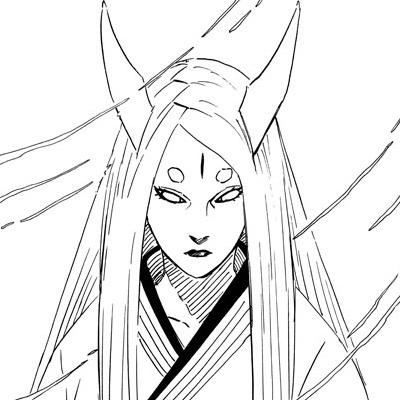
Left: Filler anime episode // Right: Manga panel

Above: Hikimayu through the ages of Japan
Another interesting fact that I’d like to point out is that Kaguya is a character with striking similarity to a Japanese folk tale, in this case the Tale of Princess Kaguya (Kaguyahime no monogatari), whose origin we can trace back to Heian Japan. The Tale of Princess Kaguya tells the story of a little baby girl who “fell from the skies” and was found by a couple of old farmers inside of a bamboo. She grew up to be extremely beautiful and was courted by lots of noblemen, but she rejected them all insisting that somebody would come for her, as she looked at the moon. Of course, Naruto provides us with a different ending to the story but this similarity can’t be overlooked.
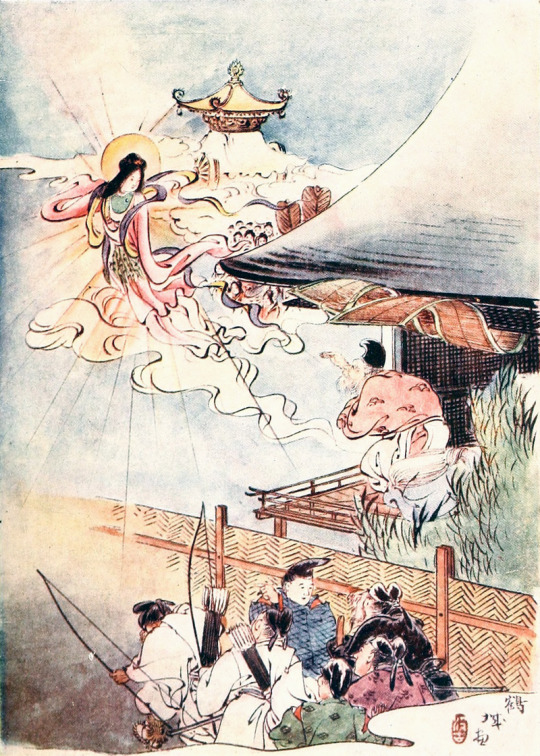
Above: "The Receding Princess" from The Japanese Fairy Book, 1908
Moving on to Tenji, it gets a bit more complicated to place him in an exact historical moment as he has elements of many different periods. His hairstyle resembles the styling of the Jomon period, whereas the entire setting in the filler episodes are more similar to the Nara period with the many small kingdoms fighting for dominance within a vast land, just like pre-unification Japan. Therefore, I place Kaguya and Tenji at the end of the Nara period, because we see how Kaguya takes over Tenji’s rulership and is regarded as a noblewoman after she casts the first Infinite Tsukuyomi. I have to rely on some filler in this case because otherwise I can’t find a logical explanation as to why Hagoromo was so well settled and had a large group of people following his teachings if it wasn’t for Kaguya ruling some land that originally belonged to Tenji.
Hagoromo and Hamura
Let’s start with the second generation. Following the events of the end of the Nara period I quoted in the previous section, Hagoromo and Hamura would go in the beginning of the Heian period. Their character designs feature long, flowy tunics without a visible belt. Here you have an image of men’s clothes through Japanese history, the third one being a feudal lord of the Heian period. Compare and contrast with these anime and manga images.
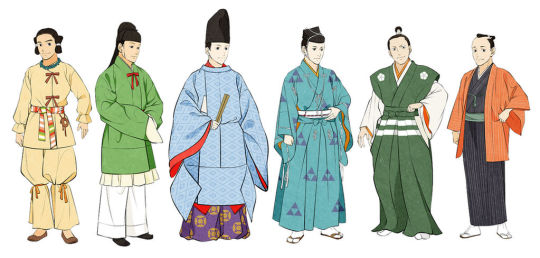
Above: “Men’s Japanese clothes” by Glimja
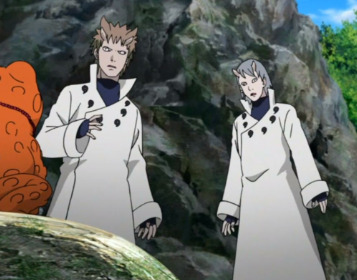

Left: Filler anime episode with both // Right: Hagoromo manga panel
Again, since we get very few manga panels related to Hagoromo and his sons, I’ll refer once again to the filler episodes where he is shown as the ruler of a village. The spot within the Heian period in which I’m placing Hagoromo would be around 100 years after the Taika reforms which established one of the first codes of law in Japan and (Taihō code) and divided the country in provinces ruled by feudal lords. Curiously, around the time where the Taika reforms happened, there was an emperor called Tenji.
Indra and Ashura
The third generation of the alien-human hybrids is here, and I place them in the Heian period as well. My main reason to consider Indra and Ashura in the Heian period is the fact that this is the exact time period where the samurai originate. A common misconception is that a samurai is a Japanese warrior highly trained in the martial arts and weapons. While this statement holds some truth, the samurai were the military social class of feudal Japan, which means that there were people who were of the samurai class but had never touched a weapon in their lives. Therefore, samurai clans were not entirely composed by warriors but also had a number of people who lived a more “civilian” lifestyle. And you may be wondering, “what do the historical samurai have to do with the ninja that we see in Naruto?”. The answer is: more than you think. Historically speaking, the ninja is a samurai specialised in stealth and sneaking, the only difference with the Naruto universe is that the ninja we know and love from the show possess chakra and perform techniques with that.
The story of Indra and Ashura is strongly tied to the origin of ninja clans in Naruto, just as the Heian period is the origin of the samurai clans. From this time period I’d like to highlight the myth of Minamoto no Yorimitsu, more commonly known as Minamoto no Raiko. His story says that he slayed demons (yes, really) and saved many maidens from being abused by drunk oni with his great sword, Dojigiri Yasutsuna. The difference between myth and legend is that myths hold some kind of historical fact whereas legends are purely fictional. Minamoto no Raiko has been heavily mythified and his story sounds unbelievable or too much like a fantasy story until you realise that he did exist and that his sword is kept in a museum. Doesn’t this resemble how the origins of ninja in Naruto are almost like fantasy stories up until Hagoromo shows up in the 4th war and explains that everything was real all along?

Above: Ukiyo-e of Minamoto no Raiko and others fighting the demon Shuten Doji.
Just as Minamoto no Raiko is considered the first samurai, Indra could be considered the first shinobi. He was the first to channel and shape chakra to create jutsu, and he was considered as part of the legends surrounding Hagoromo. Please compare these two panel sequences, one is from earlier in the story and the second one is Hagoromo’s version.
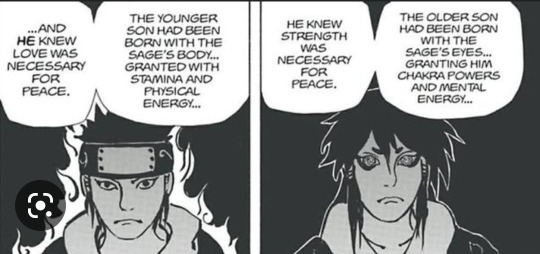

The brothers’ character design can also be correlated with the Heian period. Indra’s eyebrows seem to be real but resemble the hikimayu design of Kaguya’s eyebrows, however he does add eye makeup. The people who wore makeup in the Heian period were nobles (mostly noblewomen), once again reinforcing my point that this family started out as feudal lords and eventually fused with the warrior class, becoming ninja clans. Although the character design for Indra and Ashura isn’t 100% equal to Heian Japan’s male clothing, the inspiration is subtle yet visible. I’d say that the inspiration is mostly for the plot rather than the appearance of the character. If you’d like to see more real Heian period clothing, this link has recreations of the outfits of the characters in the Tale of Genji, by Murasaki Shikibu.
Sources
These are some useful links that I’ve referred to while writing this post. I’d like to invite you to read them if you’d like to do further research on the beautiful history of Japan.
https://www.britannica.com/biography/Tenji
https://www.britannica.com/event/Taika-era-reforms
https://www.japanhousela.com/articles/princess-kaguya-a-tale-for-the-ages
https://en.wikipedia.org/wiki/Hikimayu#:~:text=Hiki means "pull" and mayu,from sesame or rapeseed oils.
https://www.thoughtco.com/beauty-in-heian-japan-195557
https://history.hanover.edu/hhr/22/HHR2022miller.pdf
https://www.tumblr.com/heian-collection/30869762024/beauty-ideal-in-heian-japan?source=share
https://thegate12.com/article/264
Thanks for reading! Stay tuned for part 2, the Warring States era. Special thanks to @al-hekima-madara-blog for actually motivating me to write all of this down 💜
#purple rambles#purple's historical analysis#naruto#naruto shippuden#six paths#kaguya otsutsuki#hagoromo otsutsuki#hamura otsutsuki#indra otsutsuki#otsutsuki indra#ashura otsutsuki#oh goodness this was a very long post#but it was really fun to make!
109 notes
·
View notes
Text

金引草|鉄引草[Kanabikisō] Thesium chinense
It grows in fields and grasslands. The grass is about 30 centimeters tall, and at this time of year, produces the flowers about from 6 to 8 millimeters in diameter in the leaf axils. There are no petals, and what appear to be so are sepals. It is a semiparasitic plant whose roots are spherical suckers at the tip and attach to the roots of plants in the Grass family, Poaceae, and other plants.
The origin of the name is unknown. In old books, it is written as 金引草. By the way, this word 金引[Kanabiki] means trying to catch one's attention or testing the sharpness of the katana.
Well, there is a katana named 童子切[Dōjigiri], which was made by 安綱[Yasutsuna], a swordsmith of the late Heian period(794-1185,) and is a national treasure today. The name comes from the legend that 源頼光[Minamoto-no Yorimitsu] cut the demon 酒呑童子[Shuten dōji] with it. Dōjigiri is one of the sharpest swords among the many great swords, and the following episode remains. https://en.wikipedia.org/wiki/Shuten-dōji
嚴有公(家綱)以來御道具樣し御用相勤候者町田長太夫と云浪人なり此者彼御代御重寶童子切と云御太刀を樣し候六胴敷腕土壇拂ひにて有りしと、
[Gen'yūkō (Ietsuna) konokata odōgu tameshi goyō ai tsutome sōrō(sōrau) wa machida chōdayū to iu rōnin nari, kono mono ka no miyo gochōhō dōjigiri to iu ontachi wo tameshi sōrō(sōrai) mutsudō shikiude dotan barai nite arishi to,] There was a ronin named Machida Chōdayū who had been entrusted with the task of testing tools since the time of Gen'yū-kō (Lord Ietsuna, the fourth shōgun of the Tokugawa dynasty.) It was when this person tested the katana named Dōjigiri, which was a treasure in those days; the katana was said to slice through six corpses, including the arms, and bit into the foundation. From 秋霜雑纂[Shūsō Zassan] Source: https://dl.ndl.go.jp/pid/1189019/1/38 (ja) https://en.wikipedia.org/wiki/Dōjigiri https://en.wikipedia.org/wiki/Tameshigiri https://www.goodreads.com/search?query=Samurai+Executioner
18 notes
·
View notes
Text
Went into this with nothing, came out with Japanese History. Welcome to Episode 10 of (Waku) Puyo Extras: Educational Edition.

(Yeah Lagnus is in the Waku Puyo Manga. There's 3 versions of him due to him basically having DID, and he actually gets solid development. A win for all 10 of us Lagnus fans.)
Hello everyone, it's that teenage boy who spends his time looking into wacky Japanese games again, and welcome to Episode 10 of this series. Finally hit double digits for these episodes, I can finally say it can be it's own series.
With enough research finally under my belt, (whilst also reading Case Closed on my spare time, good manga,) I can finally discuss Arle's Travel Log/Arle Man'Yuki, a game I had zero idea what it was about, but came out with...mostly basic Japanese history, so this is the educational episode of this franchise.
So, what's gonna happen after this? I'm glad you asked. Y'see, on Halloween, it's Her birthday. Yeah, Her. May as well plan a special episode for that, since She's one of my personal favorite characters. It'll be like 80% of just me shitposting, so heads up.
Anywho, with that, hope you enjoy.
So, What're The Origins?
Let me make this clear: What I cover this time around is NOT the entire game. That'll take way, WAY too long, so I'm only covering the pieces I do know. Some parts may also be wrong, as I'm not an expert on Japanese History. I hope you understand.
Well, there's a lot to cover here. Arle's Travel Log was released for Windows '95 in Volume 13 of Disc Station Magazines, back in 1996.

(The artstyle given in the game.)
The game itself is text-adventure game, and oh boy, you'll be reading a LOT of text for this game. There's light gameplay elements, such as clicking specific characters for a game or a battle sequence, but they're padded out from a lot of text.
Now, what's interesting about this game is two major things. First off, the game takes actual elements from old Japanese culture and adds it into their game, but they add Puyo characters/New characters/Jump Hero characters as the historical figures instead. We'll cover the history part in a bit. As well, Arle jumps through time period after time period, ranging from the 1100s to the 1860s.
And the second thing to mention: They have Jump Hero characters in this. You rarely saw them during Compile's runtime, but they made some appearances here and there.
-----
Wait, What's Jump Hero?
I should mention this actually. Jump Hero was another series released by Compile themselves, a series of games with mixed variety in them due to spinoffs (or as they're called, Gaiden Games,) such as platformers, point-and-click adventure games, adventure games, etc. It starred Billy de Babine, the Jump Hero himself.

(Disc Station Vol. 23. Guess Arle's a Yugioh player now, or are those candy? Curiously, Billy also seems to be drawn in the Puyo~N artstyle.)
There's a ton of characters to cover that I won't be...well, covering, such as Billy Burn (or Barry de Babine), Prince Ivan the Penguin, and Margarita Linda, but for those curious, here's the link to the basics of some Jump Hero characters.
Now frankly, Jump Hero can get its own episode, but for now, this is the basics, and what you mostly need to know.
-----
And For Those Wondering What Time Periods:
Well...it's the Heian and Edo/Bakamatsu period.
The Heian Period (Heian is current day Kyoto,) was a period from 784 AD to about 1185, most notably known not only for its virtually 400 years of peace, but also the boom it had on Japanese art and poetry. It was the Golden Age for historical Japan, as due to them making their own vast differences from Chinese art, but also their literature, caused a new and unique Japanese culture.
As well, during this time, politically, Japan was an isolationist country, basically leaving itself from most worldwide talk.
The Bakamatsu Period was much shorter one, from only 1853 to 1867, based off the end of the Edo Period (1603-1867.) The Edo Period was considered the last period of peace for traditional Japan, before they went into an imperial rule, up until their defeat/surrender in WW2 in 1945. The Edo Period was a peaceful one, though for 200 years instead of 400, known best for the economic growth of the Shogunate.
Back to the Bakamatsu Period, it was the final years of traditional Japan, though they're best known for the Shinsengumi Swordsmen, a group of elite swordsmen founded from 1863 to 1869, formerly low ranked Samurais and Farmers, founded to protect the Shogunate due to a massive divide in Japanese politics.
Unfortunately, history was not on their side, and were disbanded in 1869, as well as the end of traditional Japan. You may also know the Shinsengumi from Gintama.
Yeah. There's a lot to cover.
My history may be off so take these with a grain of salt.
-----
What's The Story, Gren?
Ah, the story itself.
It begins with Arle...encountering Satan once again, who's looking to grab Carbuncle. Unfortunately, Arle isn't having any of that and so they duel. However, due to this duel, they get blasted back in time. I'm talking the 1100s back in time.
The Heian Period levels of back in time.

(WATCH OUT ARLE YOU'RE GETTING MARIO AND LUIGI: PARTNERS IN TIME'D)
And now, Arle wakes up in the 1100's. Ain't that fun?
Unsure of where to go, she just sorta wanders around, checking her surroundings and runs into Mamomo, (remember him? Me neither.) and runs into...The Old Man From Third Street from Jump Hero, in the role of an historical Onimyoji, Abe no Seimei. There's even a shrine of him in actual Japan.
And hey, there's Ivan, in the role of Fujiwara no Muchinaga, the most influential person in Japanese courts back in the 10th/11th century, as well as holding the oldest autographic diary for a historically important person.
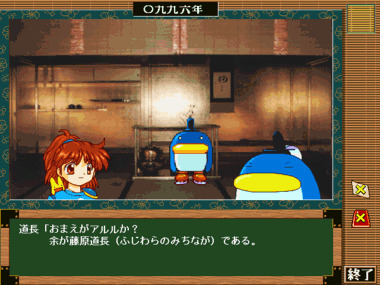
(Best image I can find...whoops.)
Throughout Arle's journey, she'll not only run into characters from Jump Hero, such as Billy de Babine posing as general Minamoto no Yoshitsune, but also Puyo/Madou characters themselves, posing as either historical figures themselves or just random people, such as Kikimora, Draco and Witch.
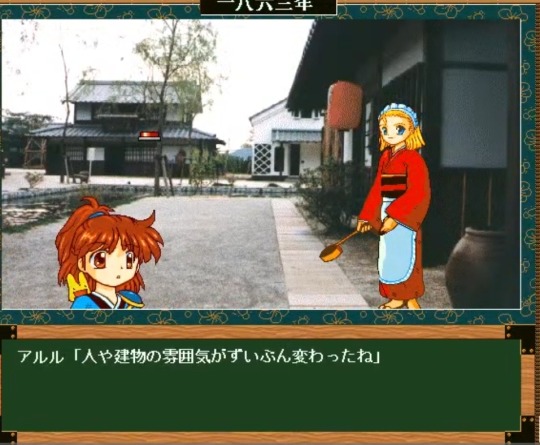

Kikimora is in a later year, I believe 1863, while Witch and Draco's in about year 1000. That's why Arle's clothes change. They both look pretty though.
Fun fact about Witch though: She does have a small game where you have to click her, but she must've mastered the damn Body Flicker from Naruto since she goes ALL OVER THE PLACE.
Now why did I say "historical figures" for some?
Well, let's take Rulue for example, playing the role of Tomoe Gozen, and my GOD was Tomoe a badass. A female Samurai, in the 1180s, there was a war going on in the late Heian Period, the Gunpei War, and in that, she was a leader, and went into battle alongside other Samurai. She's most notable not only for that, she's known to at least taken the head of one enemy (Hinda No Moroshige,) and presented it to her leader. Absolutely fucking insane.
Best part is...she was also a devoted wife. Ironic for Rulue but still.
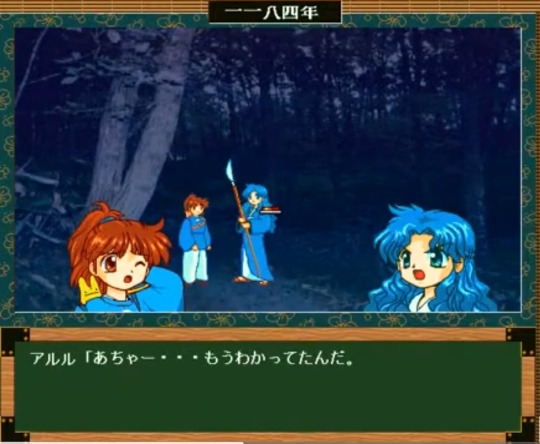
(I had to put SO much respect on her name.)
Oh, and Schezo's here too, since Rulue got the role of a badass Samurai, what did Schezo get?
OUR BOY SCHEZO IS APPARENTLY THE VICE COMMANDER OF THE SHINSENGUMI, HIJIKATA TOSHIZO.

(Vice Commander ain't bad at all. Good on you Schezo. Apparently here, he really cares for his subordinates.)
Toshizo himself had an interesting history. He began off the youngest of 10 siblings, and was raised by his 2nd older brother and his sister-in-law. Spoiled as all hell, he was handsome, but rude to all who wasn't family or friends, until he saw a swordsman from another clan commit Seppeku. He went to that man's funeral and cried.
He spent most of his youth self teaching himself swordplay, and even became friends with the future leader of the Shinsengumi, Kondo Isami. When the Shinsengumi were formed, it was him, Kondo, and two other men, however those two men were kinda assholes, and Toshizo found enough evidence to make one of them commit Seppeku, and assassinated the other. Yep. He did that.
After that, he and Kondo became the leaders of the Shinsengumi, where Toshizo was very strict on the rules, and even got the nickname of "The Demon Vice Commander," and fought in many battles in the Boshin War.
After Kondo was executed by enemy forces in April of 1868, Toshizo died in battle after giving his final farewell to his servant, as well as his katana, a death poem, as well as bits of hair and a photo of himself, in June of 1869. He knew he'd die in battle, but he'd rather die with his government than live with the shame. A week after his death, the war ended...
And that dude is Schezo now. Lmao.
Oh, and who's Kondo? The leader of the Shinsengumi?
Camus. I'm not kidding.
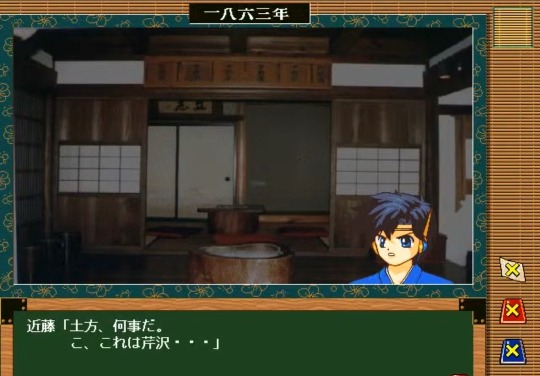
Schezo and Camus are a team. That sounds sick.
Oh, and not shown but characters who also make an appearance (because THE DANG 10 IMAGE LIMIT...):
Minotauros
Zombie
Incubus[?]
Panotty
Serilly
Draco
Nasu Grave
Suketoudara
Skeleton-T
After all this stuff occurs, the final boss of this game is...Owlbear. I mean, could be worse.
-----
After That...Lesson, How's the OST?
As the guy who listened to it...it's okay. Which isn't great for Madou standards. There's nothing honestly too standout, but you're not gonna mute the game from the songs themselves. Definition of passable.
It's honestly quite a tad disappointing that it doesn't have a banger OST, but we can make do with what we got.
-----
And Overall?
If you're willing to check out this game for its Japanese history and some of the wackiness of both Madou AND Jump Hero...I'd say check it out. The characters being played are fairly interesting, and the lore behind the actual people themselves are so...interesting.
And with that...hope you enjoyed this lesson. It was fun researching the game.
#madou monogatari#schezo puyo puyo#japanese translation#puyo puyo#sega#arle nadja#rulue puyo puyo#witch puyo puyo#japanese history#puyo#disc station#puyoposting#The History part is why this took 2 weeks...#schezo wegey
25 notes
·
View notes
Text
Watched Episode 4x05 of Superman & Lois and was overall kinda upsetty spaghetti that we didn't get to see a certain reveal, but I wanted to at least write a little more about what happened during that scene, so here's a quick fic of what I think happened and what I think Jordan was thinking!
Summary: While Jordan, Denise, Candice, and Jon were at a party, Jon had to leave Candice alone for the third time that day. Jordan and Denise chat about what to do next. Word Count: 1185 Fandoms: Superman & Lois (TV 2021) Trigger Warnings: Panic attacks
*There are spoilers for 4x05 in this*
4 notes
·
View notes
Text
🏀⛹🏿⛹🏿♂️
#سوريا syria#save syria#syrian refugees#free syria#syria news#syria#syrian civil war#syrian arab army#syrian hamster#countryhumans syria#assyria#assyriology#spotify#love#faith#news#art#nfl#nba#music#war#peace#nfl highlights#ai model#ai artwork#ai image#ai generated#ai sexy#ai woman#ai babe
2 notes
·
View notes
Text
progress report: 29/30
welp. it's not been a super great writing month for me. next time, i suppose.
the doksoo beach episode: 377
spite: 1185
Total for the day: 1562
Running totals:
mu qingfang’s terrible romcom: 1246
therapy fic: 1535
wip doc: 1740
transmigrated as the female lead’s villain fiance: 1563
you’d think this end better: 23
the doksoo beach episode: 2894
spite???: 666
12014/50000
3 notes
·
View notes
Text
THE TV NRI CANADA Satsang 05-04-2025 || Episode: 1185 Evening | Sant Ram...
0 notes
Text
John Moody is a husband, father of six, and one of the greatest voices for food freedom in America.
John and Pete discuss how we got to where we are now and the history of our food supply. He also discusses how the nation's reliance on large cities is lessened when attention is directed toward local, rural politics and our food supply.
0 notes
Text

🎨 An Online #ArtShow Everyday! 🎨
Good Morning Social Media! Today’s featured #Spotify #Playlist is: This Is:
A State Of #Trance Episode 1185 - Armin van Buuren (#AStateOfTrance) ; Mei Ling and I feature a new playlist daily. It’s what I have on here in the studio while I Paint and work. You can Listen as well, for #FREE, both here at the Link and on the Pop Culture BLOG at my website: www.JamieRoxx.us enjoy :)
🎧 #SpotifyPlaylist: https://open.spotify.com/playlist/2Ps64TVbfmfX6jxWJnlX1j
#Trance #ProgressiveTrance #ProgressiveHouse
🎨 Featured Painting: Making room in the Studio! SUMMER SALE! All of our EBAY Paintings are REDUCED!
Available #Painting:
‘Let Go’
Original #Painting
2023, acrylic and oil blend on canvas, 16"x20" by @ArtistJamieRoxx #JamieRoxx ( www.JamieRoxx.us )
�� eBay Link: www.ebay.com/itm/116026792588
Please PM or email for inquiries or questions, and/or more photos etc.
● We ship Internationally ● comes with an official, Signed Documented Provenance ● Professionally back finished and ready to hang on your wall
#PopArt #NeoGenre
. . .
#Blog #Art #LifeattheBeach #ArtistsLife #BestFriends #SharPei #Painter #NeoNoir
0 notes
Text
📹
#ArminvanBuuren
#AStateOfTrance Episode 1185 w/ #RubenDeRonde & #AlexKunnari
youtu.be/As8sa7t5Ps0
Ⓜ️
#ASOT1185
https://www.mixcloud.com/ArminvanBuuren/a-state-of-trance-episode-1185-armin-van-buuren/
📋
#ASOT Ep. 1185
trancepodcasts.com/a-state-of-trance-1185
📹
#ArmadaMusic
Ben Nicky & Creeds - Survive It (Official Lyric Video)
youtu.be/tWoLvlVVWAY
youtube
💽
#AvB - ASOT '24
https://asot.lnk.to/2024
0 notes
Text

Eva file : Angel of freedom
Tabris (تبريس)
Although Kaworu, both as a human and as an angel is always called Kaworu, he does actually have a proper angel name: Tabris. Traditionally Tabris is the angel who presides over free will, self-determination, choice and alternatives. It cannot be a coincidence that Kaworu decides, spontaneously, to be killed instead of destroying humanity like all his predecessors tried to do. An extreme choice, which does however show a very strong sense of self-determination. The fact that free-will is the greatest gift God gave to men could also be a way to underline how close Kaworu is to Adam, the mother of all Angels.
Aside from being the Angel of Free Will, Tabris is also the Apocalypse Angel, which is coherent with Kaworu being the last Angel to appear on Earth. According to the Hebraic tradition, Tabris will arrive at the end of times to break the seal to the Four Horsemen of Apocalypse (Pestilence, War, Famine and Death). According to the Hebraic interpretation, Tabris is neither a fallen angel (devil), nor a loyal angel (servant of God). It is precisely this “neutral” position, that allows him to be an executor of the world’s destruction.
Nagisa (渚)
Nagisa (渚 / なぎさ) is used both as a name or, more rarely, as a surname (as in Kaworu’s case). The kanji 渚 means «beach; shore; strand». Alternative kanji for «nagisa» are 汀, which means «shore; water’s edge» and 凪砂 which means «lull; sand». All these meanings are related in two ways to Kaworu: a beach is where he meets Shinji for the first time and again it is on a beach that Kaworu has the famous conversation with Seele.
Another interesting meaning of the kanji 渚 (nagisa) is «messenger; envoy; emissary», given by the union between the kanji シ (shi) and 者 (sha), which together form 使者 / シ者 (shisha). Indeed Shinji defined Angels as: “…messengers of God, enemies named after servants of Heaven”. and Ritsuko says Kaworu is “[…] likely the final messenger”..
The meaning of Kaworu’s surname links him to another character of Evangelion: Rei Ayanami. That’s because Rei’s surname contains the kanji 波, which means «waves; billows», thus tying both her and Kaworu to the sea.
Kaworu (カヲル)
Checking various websites dedicated name meaning it is common to find the name Kaworu spelled without the «w», therefore being 薫 (Kaoru). Back to the Heian period (794-1185) (o) and ヲ (wo) were two distinct sounds, which were later merged during the Edo period (1603-1868). While the pronunciation of these two sounds was the same, their calligraphy was still different hence the existence of the double spelling: «Kaworu» versus «Kaoru».
What remained unchanged is the meaning. As a name, «Kaworu» means «fragrance» and the verb 香る, 薫る (kaoru) means «to smell sweet, to be fragrant». Indeed another Kaworu, the protagonist of the third Tale of Genji, was born with a peculiar physical feature that perfectly fits his name: his body smelled sweet. The Genji Kaworu is a romantic, handsome and smart hero, traits that could be applied to the Evangelion Kaworu as well.
Another interesting information revealed by the Evangelion Filmbook Remix (second volume), is that Kaworu is the name of the Angel of Betrayal while Tabris (see above) is the name of the Angel of Free Will. The betrayal element could recall the «smile of betrayal»; the caption of Kaworu’s smile to Rei toward the end of episode 24. Finally, it is interesting to notice that both Nagisa and Kaworu can be used for a male or female baby. This, again, is a parallel with Rei because her name too is unisex.
Taken from Full of Grace which is no longer online
1 note
·
View note